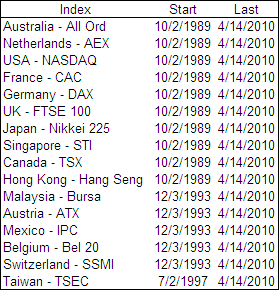 There are a vast number of technical indicators out there but which ones are best? Are any of them suitable for use in a mechanical trading model? Do any of them actually provide value over a buy and hold approach? In my experience most of the publicly available technical indicators are of little, if any value. All of our best performing models are build on completely new ideas that deviate from conventional approaches to technical analysis almost entirely.
There are a vast number of technical indicators out there but which ones are best? Are any of them suitable for use in a mechanical trading model? Do any of them actually provide value over a buy and hold approach? In my experience most of the publicly available technical indicators are of little, if any value. All of our best performing models are build on completely new ideas that deviate from conventional approaches to technical analysis almost entirely.
But questions remain: what length of moving average provides the best signals? Is it better to use a simple or exponential moving average? Quality answers to these questions are few and far between and often the process people use to establish such answers are majorly flawed.
.
Common Flaws in Testing Technical Indicators and Systems
.
- Curve Fitting – Only Testing On One Stock or Index (usually the S&P 500) Even if a test period covers many years of data to only test one index will produce results that fit that curve. Also the US market has been one of the top performers over the last 100 years but will it be a top performer over the next 100? Japan has experienced a bear market over the last 20 years so vicious that it has seen the the Nikkei 225 down over 80% from its peak. To get an accurate idea of the effectiveness of an indicator it must be tested on several unrelated securities across the full spectrum of performance possibilities..
- Testing A Range Of Individual Securities There are several misleading factors that come from testing a range of individual securities, the most troublesome one being the survivor-ship bias. If I was to test a random selection of stocks then one necessary criteria would be to select from a group of stocks that had been around long enough to provide adequate data for testing. But by selecting from stocks with enough data I would only be selecting randomly from stocks that had survived over that period and would be ignoring those that failed or had been de-listed. This is not how things work in the real world and would produce artificially inflated results..Another challenge with testing idividual securities is choosing the sellection criteria for which stocks to include. At which point should a cut off be made based on price, volume, market cap etc? Some stocks are going to have an excess or lack of volatility and there may be a large amount of noise in the data. This will make it difficult for even the best technical indicators to produce profitable signals and to limit losses.
.
A Less Flawed Method
.
There is no perfect way to test an indicator or system using historical data because past performance is no guarantee of future results. However the markets are driven by human emotion and crowd psychology. I believe that this behavior follows repeated patters and that effective historical testing can identify these patterns. In this way we can look to the past for an indication of the likely future.
In an attempt to be more effective at identifying patterns that are likely to repeat as opposed to coincidental repetition of behavior from the past, we will test across several global indexes that have many years of accurate data available. This way there is no survivor-ship bias and each indicator can be tested through varying market types. Here is a list of the 16 global indexes that will be used for the testing process along with the data range for each:
.

.
That is a total 109,539 days or 300 years* of data covering extended bull, bear and crab markets. I am confident that due to the size of this data sample identifying the best parameters for each indicator through brute force of testing them all will not result in curve fitting and the statistics obtained will provide an accurate platform for a bare knuckle, Technical Indicator – Fight for Supremacy.^
.
Human psychology molds the value system that drives a competitive market economy. And that process is inextricably linked to human nature, which appears essentially immutable and, thus, anchors the future to the past. – Former Fed Chief Alan Greenspan
.
Technical Indicators On The Fight Card (So far) – more
.
Moving Averages – info
.
- Simple Vs Exponential Moving Averages, Completed – Results
- Simple Moving Average (SMA)
- Exponential Moving Average (EMA)
- Double Exponential Moving Average (D-EMA)
.
- Double Vs Triple Exponential Moving Average, Completed – Results
- Double Exponential Moving Average (D-EMA)
- Triple Exponential Moving Average (T-EMA)
.
- Reduced Lag Moving Averages
- Zero Lag EMA (ZL-EMA)
- Almost Zero Lag EMA (AZL-EMA)
- Zero Lag Error Correcting EMA (EC-EMA)
- Hull Moving Average (H-MA)
- Modified Moving Average (M-MA)
- 3rd Generation Moving Average (3G-MA)
.
- Weighted Moving Averages, Completed – Results
- Weighted Moving Average (W-MA)
- Triangular Exponential Moving Average (TriW-MA)
- Sine Weighted Moving Average (SW-MA)
.
- Mixed Moving Averages, Completed – Results
- Time Series Forecast or Moving Linear Regression (TSF)
- Linear Regression Indicator (LRI)
- Wilder’s Smoothing AKA Smoothed MA (WS-MA)
- Triangular Simple MA (TriS-MA)
.
Intelligent Moving Averages
.
These require a volatility index or ratio of some kind and we will be testing the following as components:
- Standard Deviation Ratio (SDR)
- Efficiency Ratio (ER)
- Relative Volatility Index (RVI)
- Vertical Horizontal Filter (VHF)
- Fractal Dimension (D)
- Z Score (ZS)
- Chaikin’s Volatility (CV) >
- Dreiss Choppiness Index (CI) >
> We currently lack High and Low Prices for some test markets.
.
- Variable Moving Average (VMA) aka Volatility Index Dynamic Average (VIDYA)
- Standard Deviation Ratio – Completed – Results (SDR-VMA)
- Efficiency Ratio – Completed – Results (ER-VMA)
- Relative Volatility Index – Completed – Results (RVI-VMA)
- Vertical Horizontal Filter – Completed – Results (VHF-VMA)
- Fractal Dimension Completed – Results (D-VMA)
- Adaptive Moving Average (AMA) aka Kaufman Adaptive Moving Average (KAMA)
- Efficiency Ratio – Completed – Results (ER-AMA)
- Fractal Dimension – Completed – Results (D-AMA)
- Standard Deviation Ratio – Completed – Results (SDR-AMA)
- Relative Volatility Index – Completed – Results (RVI-AMA)
- Vertical Horizontal Filter – Completed – Results (VHF-AMA)
- Log Normal Moving Average (LAMA)
- Fractal Adaptive Moving Average (FRAMA) – Completed – Results
Standard Deviation RatioEfficiency RatioRelative Volatility IndexVertical Horizontal Filter
.
- Other Intelligent Moving Averages
- McGinley Dynamic Indicator
- MESA Adaptive Moving Average and Following Average FAMA (MAMA)
.
MACD
- Moving Average Crossovers – Completed – Golden Cross – Which is the best?
- Moving Average Convergence Divergence (MACD) – Completed – Results
- ZeroLag MACD (ZL-MACD)
- MACD Z Score (MAC-Z)
.
‘Index’ Indicators
- Relative Strength Index (RSI) – Completed – Results
- Relative Momentum Index (RMI)
- Dynamic Momentum Index (DMI)
- Relative Volatility Index (RVI)
.
Oscillators
- Stochastic Oscillator (SO) – Completed – Results
- Stochastic Momentum Index (SMI)
- Projection Oscillator (PRO)
- Ultimate Oscillator (UO)
- Rolling EV Ratio (R-EVR)
.
Mixed Indicators
- Parabolic SAR (PSAR)
- Aroon (AN)
- Directional Movement (DM)
- Smoothing the Bollinger %b (SB%b)
- Vertical Horizontal Filter (VHF)
.
It is going to take a while to work through all of this and compile the data so we will update it regularly with the latest results. Are there any indicators that you think we should add to the list or trading systems that you want tested? To be suitable for testing they must be able to produce clear entry and exit signals and not require volume data (we don’t yet have access to enough historical volume). If you have any of the formulas that we are missing or wish to add an indicator to the fight card then the formula would be preferred in excel format.
And now… for the 1000s in attendance and the millions watching around the world, Ladies and Gentlemen, LLLLLET’S GET READY TO RUMBLE!
.
- * Unless otherwise stated 104 weeks of data for each index has been ‘left in’ as lead time for indicators that require a lot of data to get their first signal such as a 50 week double exponential moving average. On some occasions this lead time may not be enough and this could negatively affect the results for an indicator with a massive lead in time because the additional down time (the early 90s) was typically a bullish period globally.
- ^ All testing has and will be performed mechanically and every effort is made to ensure accuracy but there is the possibility that some errors have over looked. Please do your own research and remember that the information provided here is for entertainment purposes only.